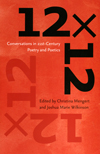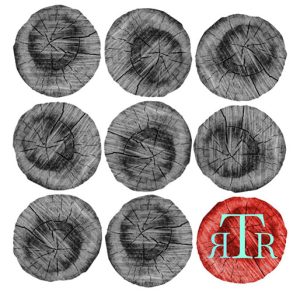12 x 12
In this interesting anthology of modern poetry the editors have chosen to emphasize the craft of poetry, as well as its creations. All too often, either out of a desire to demonstrate important developments or to present only the work that will be preserved for posterity on the part of editors, contemporary poetry anthologies are at least a generation behind. These anthologies seem interested only in “poetry [that] was poetry, not a poet writing. Shakespeare was poetry. Blake and Dickinson were poetry.” The regulating of poetry to the past tense has in a way marginalized working writers, whose craft it sometimes seems is only discussed seriously in MFA programs and literary journals. 12 x 12 changes that by bringing the discussion of craft into the foreground. To accomplish this, the editors had emerging poets speak with established ones who had influenced their writing. These conversations are bookended by selections from each of the contributors.
In this interesting anthology of modern poetry the editors have chosen to emphasize the craft of poetry, as well as its creations. All too often, either out of a desire to demonstrate important developments or to present only the work that will be preserved for posterity on the part of editors, contemporary poetry anthologies are at least a generation behind. These anthologies seem interested only in “poetry [that] was poetry, not a poet writing. Shakespeare was poetry. Blake and Dickinson were poetry.” The regulating of poetry to the past tense has in a way marginalized working writers, whose craft it sometimes seems is only discussed seriously in MFA programs and literary journals. 12 x 12 changes that by bringing the discussion of craft into the foreground. To accomplish this, the editors had emerging poets speak with established ones who had influenced their writing. These conversations are bookended by selections from each of the contributors.
The selections included cover the spectrum of possibility, from wildly experimental and modern to formalist and romantic. This stylistic range illustrates what Rosemarie Waldrop recognizes as, “a great opening of the field.” As she observes, “there are many more poetries getting a hearing/showing than before. And while there is of course much that I find dull, there is lots of energy – and surprises.” The patient reader of 12 x 12 will no doubt experience this opening of the field, and at times in a very exciting and visceral way.
But the reader will also experience something else. As editor Joshua Marie Wilkinson points out there is a “strange simultaneity of how far-reaching the conversations are, how unique the poems are, on the one hand; and on the other hand, how much overlap, continuity, and shared ground of influence there is among these twenty-four writers.” Both John Ashberry and Emily Dickinson come up a lot. Artistic preoccupations also often reemerge, like how does one make relevant poetry in our noisy modern world and of course are these poems any good?
One topic that comes up in every conversation is influence. Some revolve around it, building on shared admiration and early readings. As Laura Mullen observes in one of the early dialogues she is “always being influenced. The question is indeed the one you ask: by who and when (along with the question of how). So any list I make here is going to leave way too many writers, artists, lovers and landscapes out!” The conversations in 12 x12 not only show the poet at her writing desk but also by her book lamp and record player.
When Emerson said “First we eat, then we beget; first we read, then we write.” it was not an exaggeration by any means and 12 x 12 presents writers who are working through this process of engagement and creation aloud. Hopefully the impressions that these dialogues leave will help to dispel the myth of the solitary American poet, cutoff from society at large by eccentricity and creativeness; and bring about a better understanding of the medium which Allen Grossman described as “the least solitary of enterprises” and its twenty-first century practitioners.





